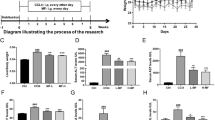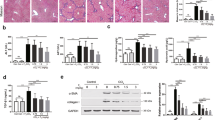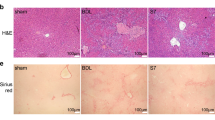Abstract
Hepatic fibrosis is a dynamic process that involves the interplay of different cell types in the hepatic tissue. Connective tissue growth factor (CTGF) is a highly profibrogenic molecule and plays a crucial role in the pathogenesis of hepatic fibrosis. The aim of the present investigation was three-fold. First, we studied the expression of CTGF in the cultured hepatic stellate cells using immunohistochemical technique. Second, we induced hepatic fibrosis in rats through serial intraperitoneal injections of N-nitrosodimethylamine (NDMA; dimethylnitrosamine, DMN) and studied the upregulation of CTGF and TGF-β1 during hepatic fibrogenesis. Third, we downregulated CTGF expression using CTGF siRNA and examined the role of CTGF siRNA to prevent the progression of NDMA-induced hepatic fibrosis. The results depicted strong staining of CTGF in the transformed hepatic stellate cells in culture. Serial administrations of NDMA resulted in activation of hepatic stellate cells, upregulation of CTGF and TGF-β1 both at mRNA and protein levels and well-developed fibrosis in the liver. Immunostaining, Western blot analysis, semiquantitative and real-time RT-PCR studies showed downregulation of CTGF and TGF-β1 after treatment with CTGF siRNA. The results of the present study demonstrated that CTGF gene silencing through siRNA reduces activation of hepatic stellate cells, prevents the upregulation of CTGF and TGF-β1 gene expression and inhibits accumulation of connective tissue proteins in the liver. The data further suggest that knockdown of CTGF upregulation using siRNA has potential therapeutic application to prevent hepatic fibrogenesis.
This is a preview of subscription content, access via your institution
Access options
Subscribe to this journal
Receive 12 print issues and online access
$259.00 per year
only $21.58 per issue
Buy this article
- Purchase on Springer Link
- Instant access to full article PDF
Prices may be subject to local taxes which are calculated during checkout








Similar content being viewed by others
References
George J, Stern R . Serum hyaluronan and hyaluronidase: very early markers of toxic liver injury. Clin Chim Acta 2004; 348: 189–197.
George J, Chandrakasan G . Molecular characteristics of dimethylnitrosamine induced fibrotic liver collagen. Biochim Biophys Acta 1996; 1292: 215–222.
George J, Tsutsumi M, Takase S . Expression of hyaluronic acid in N-nitrosodimethylamine induced hepatic fibrosis in rats. Int J Biochem Cell Biol 2004; 36: 307–319.
Siegmund SV, Brenner DA . Molecular pathogenesis of alcohol-induced hepatic fibrosis. Alcohol Clin Exp Res 2005; 29: 102S–109S.
Paradis V, Dargere D, Vidaud M, De Gouville AC, Huet S, Martinez V et al. Expression of connective tissue growth factor in experimental rat and human liver fibrosis. Hepatology 1999; 30: 968–976.
Hayashi N, Kakimuma T, Soma Y, Grotendorst GR, Tamaki K, Harada M et al. Connective tissue growth factor is directly related to liver fibrosis. Hepatogastroenterology 2002; 49: 133–135.
Rachfal AW, Brigstock DR . Connective tissue growth factor (CTGF/CCN2) in hepatic fibrosis. Hepatol Res 2003; 26: 1–9.
Abou-Shady M, Friess H, Zimmermann A, di Mola FF, Guo XZ, Baer HU et al. Connective tissue growth factor in human liver cirrhosis. Liver 2000; 20: 296–304.
Liu X, Hu H, Yin JQ . Therapeutic strategies against TGF-beta signaling pathway in hepatic fibrosis. Liver Int 2006; 26: 8–22.
Paradis V, Dargere D, Bonvoust F, Vidaud M, Segarini P, Bedossa P . Effects and regulation of connective tissue growth factor on hepatic stellate cells. Lab Invest 2002; 82: 767–774.
Grotendorst GR . Connective tissue growth factor: a mediator of TGF-beta action on fibroblasts. Cytokine Growth Factor Rev 1997; 8: 171–179.
Leask A, Abraham DJ . The role of connective tissue growth factor, a multifunctional matricellular protein, in fibroblast biology. Biochem Cell Biol 2003; 81: 355–363.
Holmes A, Abraham DJ, Chen Y, Denton C, Shi-wen X, Black CM et al. Constitutive connective tissue growth factor expression in scleroderma fibroblasts is dependent on Sp1. J Biol Chem 2003; 278: 41728–41733.
Duncan MR, Frazier KS, Abramson S, Williams S, Klapper H, Huang X et al. Connective tissue growth factor mediates transforming growth factor beta-induced collagen synthesis: down-regulation by cAMP. FASEB J 1999; 13: 1774–1786.
Wang JF, Olson ME, Ma L, Brigstock DR, Hart DA . Connective tissue growth factor siRNA modulates mRNA levels for a subset of molecules in normal and TGF-beta 1-stimulated porcine skin fibroblasts. Wound Repair Regen 2004; 12: 205–216.
George J, Chandrakasan G . Biochemical abnormalities during the progression of hepatic fibrosis induced by dimethylnitrosamine. Clin Biochem 2000; 33: 563–570.
George J, Chandrakasan G . Lactate dehydrogenase isoenzymes in dimethylnitrosamine induced hepatic fibrosis in rats. J Clin Biochem Nutr 1997; 22: 51–62.
George J, Chandrakasan G . Glycoprotein metabolism in dimethylnitrosamine induced hepatic fibrosis in rats. Int J Biochem Cell Biol 1996; 28: 353–361.
George J, Rao KR, Stern R, Chandrakasan G . Dimethylnitrosamine-induced liver injury in rats: the early deposition of collagen. Toxicology 2001; 156: 129–138.
Ala-Kokko L, Pihlajaniemi T, Myers JC, Kivirikko KI, Savolainen ER . Gene expression of type I, III and IV collagens in hepatic fibrosis induced by dimethylnitrosamine in the rat. Biochem J 1987; 244: 75–79.
Chichibu K, Matsuura T, Shichijo S, Yokoyama MM . Assay of serum hyaluronic acid in clinical application. Clin Chim Acta 1989; 181: 317–323.
Smith PK, Krohn RI, Hermanson GT, Mallia AK, Gartner FH, Provenzano MD et al. Measurement of protein using bicinchoninic acid. Anal Biochem 1985; 150: 76–85.
Rippe RA . Role of transcriptional factors in stellate cell activation. Alcohol Clin Exp Res 1999; 23: 926–929.
Dykxhoorn DM, Lieberman J . Knocking down disease with siRNAs. Cell 2006; 126: 231–235.
Zhou D, He QS, Wang C, Zhang J, Wong-Staal F . RNA interference and potential applications. Curr Top Med Chem 2006; 6: 901–911.
Wadhwa R, Kaul SC, Miyagishi M, Taira K . Know-how of RNA interference and its applications in research and therapy. Mutat Res 2004; 567: 71–84.
George J . Ascorbic acid concentrations in dimethylnitrosamine-induced hepatic fibrosis in rats. Clin Chim Acta 2003; 335: 39–47.
George J . Mineral metabolism in dimethylnitrosamine induced hepatic fibrosis. Clin Biochem 2006; 39: 984–991.
Rachfal AW, Brigstock DR . Connective tissue growth factor (CTGF/CCN2) in hepatic fibrosis. Hepatol Res 2003; 26: 1–9.
Pan LH, Beppu T, Kurose A, Yamauchi K, Sugawara A, Suzuki M et al. Neoplastic cells and proliferating endothelial cells express connective tissue growth factor (CTGF) in glioblastoma. Neurol Res 2002; 24: 677–683.
Chen Y, Segarini P, Raoufi F, Bradham D, Leask A . Connective tissue growth factor is secreted through the Golgi and is degraded in the endosome. Exp Cell Res 2001; 271: 109–117.
Li G, Xie Q, Shi Y, Li D, Zhang M, Jiang S et al. Inhibition of connective tissue growth factor by siRNA prevents liver fibrosis in rats. J Gene Med 2006; 8: 889–900.
Sedlaczek N, Jia JD, Bauer M, Herbst H, Ruehl M, Hahn EG et al. Proliferating bile duct epithelial cells are a major source of connective tissue growth factor in rat biliary fibrosis. Am J Pathol 2001; 158: 1239–1244.
Uchio K, Graham M, Dean NM, Rosenbaum J, Desmouliere A . Down-regulation of connective tissue growth factor and type I collagen mRNA expression by connective tissue growth factor antisense oligonucleotide during experimental liver fibrosis. Wound Repair Regen 2004; 12: 60–66.
Shin JY, Hur W, Wang JS, Jang JW, Kim CW, Bae SH et al. HCV core protein promotes liver fibrogenesis via up-regulation of CTGF with TGF-beta1. Exp Mol Med 2005; 37: 138–145.
Hsu YC, Chiu YT, Lee CY, Lin YL, Huang YT . Increases in fibrosis-related gene transcripts in livers of dimethylnitrosamine-intoxicated rats. J Biomed Sci 2004; 11: 408–417.
Breitkopf K, Haas S, Wiercinska E, Singer MV, Dooley S . Anti-TGF-beta strategies for the treatment of chronic liver disease. Alcohol Clin Exp Res 2005; 29: 121S–131S.
Gressner AM, Yagmur E, Lahme B, Gressner O, Stanzel S . Connective tissue growth factor in serum as a new candidate test for assessment of hepatic fibrosis. Clin Chem 2006; 52: 1815–1817.
Igarashi A, Okochi H, Bradham DM, Grotendorst GR . Regulation of connective tissue growth factor gene expression in human skin fibroblasts and during wound repair. Mol Biol Cell 1993; 4: 637–645.
Grotendorst GR, Okochi H, Hayashi N . A novel transforming growth factor beta response element controls the expression of the connective tissue growth factor gene. Cell Growth Differ 1996; 7: 469–480.
Holmes A, Abraham DJ, Sa S, Shiwen X, Black CM, Leask A . CTGF and SMADs, maintenance of scleroderma phenotype is independent of SMAD signaling. J Biol Chem 2001; 276: 10594–10601.
Leask A, Holmes A, Abraham DJ . Connective tissue growth factor: a new and important player in the pathogenesis of fibrosis. Curr Rheumatol Rep 2002; 4: 136–142.
Ihn H . Pathogenesis of fibrosis: role of TGF-beta and CTGF. Curr Opin Rheumatol 2002; 14: 681–685.
Duncan MR, Frazier KS, Abramson S, Williams S, Klapper H, Huang X et al. Connective tissue growth factor mediates transforming growth factor beta-induced collagen synthesis: down-regulation by cAMP. FASEB J 1999; 13: 1774–1786.
Ball DK, Moussad EE, Rageh MA, Kemper SA, Brigstock DR . Establishment of a recombinant expression system for connective tissue growth factor (CTGF) that models CTGF processing in utero. Reproduction 2003; 125: 271–284.
Acknowledgements
This work was supported by the Grant for Scientific Research (C) (No. 10670515) from the Ministry of Education, Science and Culture, Government of Japan and Grant No. H2002-6 for Project Research, High Technology Center, Kanazawa Medical University, Japan.
Author information
Authors and Affiliations
Corresponding author
Rights and permissions
About this article
Cite this article
George, J., Tsutsumi, M. siRNA-mediated knockdown of connective tissue growth factor prevents N-nitrosodimethylamine-induced hepatic fibrosis in rats. Gene Ther 14, 790–803 (2007). https://doi.org/10.1038/sj.gt.3302929
Received:
Revised:
Accepted:
Published:
Issue Date:
DOI: https://doi.org/10.1038/sj.gt.3302929
Keywords
This article is cited by
-
Hepatic Sinusoid Capillarizate via IGTAV/FAK Pathway Under High Glucose
Applied Biochemistry and Biotechnology (2024)
-
CCN2/CTGF promotes liver fibrosis through crosstalk with the Slit2/Robo signaling
Journal of Cell Communication and Signaling (2023)
-
Surgical implantation of human adipose derived stem cells attenuates experimentally induced hepatic fibrosis in rats
Molecular Medicine (2022)
-
Metabolism of N-nitrosodimethylamine, methylation of macromolecules, and development of hepatic fibrosis in rodent models
Journal of Molecular Medicine (2020)
-
ERK1/2 drives IL-1β-induced expression of TGF-β1 and BMP-2 in torn tendons
Scientific Reports (2019)



